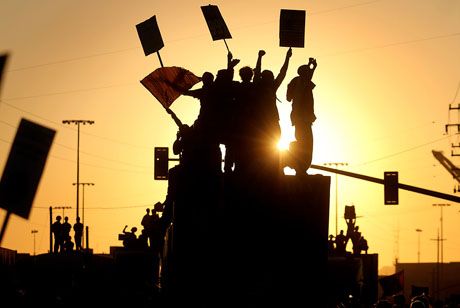Features
You are here
Fight McGuinty's Austerity agenda

February 27, 2012
On February 15, the much anticipated Drummond Commission issued its 1% solution for the rest of Ontario.
Ten months ago, Ontario Premier Dalton McGuinty appointed former TD Bank Economist Don Drummond to head the Commission on the Reform of Ontario’s Public Services, to deal with a projected (and likely overestimated) debt of approximately $16 billion.
Ontario’s deficit was a result of the global economic crisis triggered by the gang of banking bandits to which Drummond belongs, but Dalton McGuinty asked the same gang to suggest remedies.
It is therefore not surprising that the Commission’s recommendations are heavily biased in favour of the 1%. Despite rhetoric to the contrary, the pain will be absorbed by the most vulnerable in society and ordinary working people, because McGuinty directed Drummond not to keep revenue generation off the table, including increasing taxes for profitable corporations or for the 1%.
Instead, Drummond proposes a host of new or increased user fees, including post-secondary tuition fees, which would hit low- and modest-income earners hardest.
Drummond admits his recipe for balanced budgets in 2017-2018 entails sharper and deeper cuts than those meted out by former Conservative Premier Mike Harris in the mid-1990s—and for a much longer period of time.
Drummond estimates that spending cuts will be the equivalent of a permanent 16.2 per cent cut for every man, woman and child in Ontario. And of course, not every Ontarian relies on such services to the same extent, guaranteeing that those at the bottom of the economic hierarchy will experience the sharpest cuts.
But Ontario is already at the bottom of the heap in terms of provincial per capita spending on social programs, a fact even Drummond is forced to acknowledge. Clearly public sector workers and social programs are not “out of control” as the rest of the report would have us all believe. It is McGuinty’s huge tax giveaways that are out of control—$4.5 billion annually when fully phased-in. Drummond’s report is really proposing a way to pay for those tax cuts.
In order maintain existing services in line with inflation and population growth, public spending would need to increase by about 3.1 per cent annually. Instead, Drummond wants to limit spending increases so low that the effect would be deep cuts ranging from 0.6 to 5.5 per cent.
To meet these devastating targets, Drummond recommends measures that, while avoiding legislated public sector wage freezes, will have the same effect. He calls for:
The further privatization of service delivery, reducing staff;
Greater management rights to discipline, dismiss and move employees;
Funding envelopes with no wage increases, resulting in harsher negotiations;
Restructuring of the arbitration process to allow maximum flexibility for employers while imposing arbitrators on workers;
More performance pay for management (with no recommended pay caps).
Throughout the entire 543-page report, Drummond takes shots at “public sector pay”, pensions, and supposedly inflexible collective agreements.
The Drummond report is a recipe for disaster—of falling wages, rising unemployment, reduced consumer confidence, and a diminished market for small and medium businesses that, above all else, require customers with disposable income. The likely result of Drummond’s proposals is a double-dip recession and a worsening fiscal outlook.
Drummond’s every recommendation embodies a strategy of paying workers less. Some economists have estimated that Drummond’s proposals will result in a quarter of a million jobs lost, pushing the unemployment rate up to 11 per cent. Such a disaster would worsen the deficit, since it would increase pressure on the social safety net and decrease revenue.
But Drummond’s report does not represent the only solution we have to the economic crisis. He overstates the problem and leaves out taxing the rich as an option.
That’s why the April 21 demonstration at Queen’s Park is so important, as are mobilizations by the federal public service planned for March. Defenders of social justice should mobilize wherever possible for these demonstrations.
The 99% must be heard. Dalton McGuinty must reject the banker’s budget, and instead implement a budget that works for the 99 %.
Section:
Topics:
- Log in to post comments










